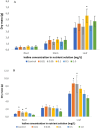Effect of iodine species on biofortification of iodine in cabbage plants cultivated in hydroponic cultures
- PMID: 38982208
- PMCID: PMC11233580
- DOI: 10.1038/s41598-024-66575-z
Effect of iodine species on biofortification of iodine in cabbage plants cultivated in hydroponic cultures
Abstract
Iodine is an essential trace element in the human diet because it is involved in the synthesis of thyroid hormones. Iodine deficiency affects over 2.2 billion people worldwide, making it a significant challenge to find plant-based sources of iodine that meet the recommended daily intake of this trace element. In this study, cabbage plants were cultivated in a hydroponic system containing iodine at concentrations ranging from 0.01 to 1.0 mg/L in the form of potassium iodide or potassium iodate. During the experiments, plant physiological parameters, biomass production, and concentration changes of iodine and selected microelements in different plant parts were investigated. In addition, the oxidation state of the accumulated iodine in root samples was determined. Results showed that iodine addition had no effect on photosynthetic efficiency and chlorophyll content. Iodide treatment did not considerably stimulate biomass production but iodate treatment increased it at concentrations less than 0.5 mg/L. Increasing iodine concentrations in the nutrient solutions increased iodine content in all plant parts; however, the iodide treatment was 2-7 times more efficient than the iodate treatment. It was concluded, that iodide addition was more favourable on the target element accumulation, however, it should be highlighted that application of this chemical form in nutrient solution decreased the concetrations of selected micoelement concentration comparing with the control plants. It was established that iodate was reduced to iodide during its uptake in cabbage roots, which means that independently from the oxidation number of iodine (+ 5, - 1) applied in the nutrient solutions, the reduced form of target element was transported to the aerial and edible tissues.
© 2024. The Author(s).
Conflict of interest statement
The authors declare no competing interests.
Figures



Similar articles
-
Iodine Biofortification of Four Brassica Genotypes is Effective Already at Low Rates of Potassium Iodate.Nutrients. 2019 Feb 21;11(2):451. doi: 10.3390/nu11020451. Nutrients. 2019. PMID: 30795581 Free PMC article.
-
Biofortification of lettuce (Lactuca sativa L.) with iodine: the effect of iodine form and concentration in the nutrient solution on growth, development and iodine uptake of lettuce grown in water culture.J Sci Food Agric. 2010 Apr 15;90(5):906-13. doi: 10.1002/jsfa.3902. J Sci Food Agric. 2010. PMID: 20355129
-
Iodide and iodate effects on the growth and fruit quality of strawberry.J Sci Food Agric. 2017 Jan;97(1):230-235. doi: 10.1002/jsfa.7719. Epub 2016 Apr 28. J Sci Food Agric. 2017. PMID: 26992053
-
Biofortification of edible plants with selenium and iodine - A systematic literature review.Sci Total Environ. 2021 Feb 1;754:141983. doi: 10.1016/j.scitotenv.2020.141983. Epub 2020 Aug 28. Sci Total Environ. 2021. PMID: 33254892
-
Microbial Transformation of Iodine: From Radioisotopes to Iodine Deficiency.Adv Appl Microbiol. 2017;101:83-136. doi: 10.1016/bs.aambs.2017.07.002. Epub 2017 Sep 7. Adv Appl Microbiol. 2017. PMID: 29050668 Review.
Cited by
-
Combined bio fortification of spinach plant through foliar spraying with iodine and selenium elements.Sci Rep. 2025 Feb 25;15(1):6722. doi: 10.1038/s41598-025-91554-3. Sci Rep. 2025. PMID: 40000817 Free PMC article.
References
-
- World Health Organization. Assessment of iodine deficiency disorders and monitoring their elimination: A guide for programme managers. 1 (2007).
-
- Desta AA, Kulkarni U, Abraha K, Worku S, Sahle BW. Iodine level concentration, coverage of adequately iodized salt consumption and factors affecting proper iodized salt utilization among households in North Ethiopia: A community based cross sectional study. BMC Nutr. 2019;5:28. doi: 10.1186/s40795-019-0291-x. - DOI - PMC - PubMed
MeSH terms
Substances
Grants and funding
LinkOut - more resources
Full Text Sources

